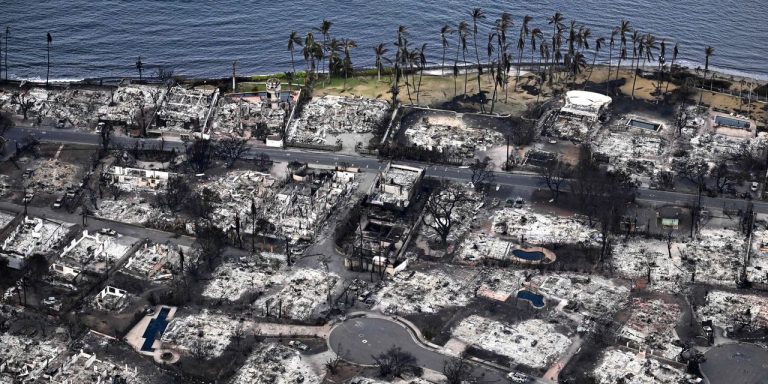The devastating blazes in Maui are a stark reminder of the growing risk that homeowners face from catastrophes such as wildfires, storms, and floods.
Dry conditions, low humidity, and high winds from a hurricane churning hundreds of miles to the south of Hawaii helped fuel the flames that killed at least 80 people and destroyed the historic town of Lahaina. Hawaii’s governor Josh Green said the wildfires were “likely the largest natural disaster in Hawaii’s state history.”
Insurance broker
Aon
(ticker: AON) on Friday said the devastation “will likely drive economic and insured losses into the hundreds of millions” of dollars but warned that “given that this situation is still ongoing, losses may continue to increase.” The Pacific Disaster Center and the Federal Emergency Management Agency estimated the cost to rebuild at $5.52 billion, according to a Facebook post on Saturday by the County of Maui.
As severe weather and natural disasters inflict more damage on homes and properties, people are increasingly seeking protection against potential losses. That means brisk business for insurers—and opportunities for investors.
According to Adam Klauber, analyst at William Blair, a “massive opportunity” is building in the homeowners insurance sector, which will also provide “significant” investment opportunities.
Still, the Maui wildfires come at a time of flux for the insurance industry: people living in fire- and hurricane-prone areas are paying more for coverage but getting less protection as insurance companies raise premiums and deductibles and limit how much they will cover—or restrict coverage altogether.
While most natural events are covered by homeowners insurance, “those that impact a smaller range of geographies such as earthquakes, wildfires, and floods require separate policies,” Klauber said in a research note published Friday.
That shouldn’t crimp the need for insurance to cover other risks, however.
“Demand for homeowners insurance has arguably never been higher than in the current macro environment, with homeownership rates, property valuations, and risk levels all elevated,” Klauber said. “As a result, premium growth, which had remained relatively consistent following the housing crisis, has picked up considerably.”
Premium growth in the industry has run in the 6% to 9% range over the past three years compared with the typical 3% to 5% range, and could be over 10% going forward, said Klauber.
He sees “a strong growth opportunity in an already massive market.” Premium revenue is primed to expand from $130 billion today to $200 billion in the next five years, Klauber said. That’s good news for the carriers.
Klauber initiated coverage on two “technology-forward” homeowners insurers,
HCI Group
(HCI) and
Hippo Holdings
(HIPO), both with a Market Perform rating.
While both companies are good growth stories and should benefit from the expansion of the homeowners insurance sector, the rating reflects the fact that William Blair needs to see more consistent profitability “before we are confident in the stocks’ ability to outperform,” the note said.
Shares of HCI have soared this year, up 48%. Over the past 12 months they have gained 1.5%. Hippo’s shareholders have not been as fortunate: the stock is down nearly 30% this year and more than 60% over the past year. Last September, the digital insurance company laid off about 10% of its workforce as underwriting losses mounted.
One element that helps HCI stand out in the crowd is its use of technology, which is becoming increasingly important as insurers try to assess and price the risks associated with severe-weather events.
“HCI is an example of a provider in the broader home coverage space that has used analytics to increase the number of data points used in the underwriting process to achieve more detailed risk assessment,” said Klauber.
Several others stand to benefit from the rising opportunity in the homeowners market, he said, including Outperform-rated stocks
Palomar
(PLMR) and
Crawford & Co.
(CRD.B).
The insurance industry is notoriously slow to change, Klauber said, but relative newcomers, such as specialty insurer
Palomar,
have an edge when it comes to the latest technology. The company, which was founded in 2014, provides insurance for earthquakes, hurricanes, and floods.
“Palomar has a modern processing technology set, so they’re much better able to take upgraded analytics and implement them into the insurance product,” Klauber told Barron’s. “They’re marrying that new technology with a new analytics platform to better underwrite the risk.”
He added: “A good part of what they do is that they geocode the risk to the address level. So they look under the ground—so one house could be built on bedrock, the other one could be built on sand—so they know to charge a much different price. The industry doesn’t have that capability.”
Palomar has also maintained a healthy combined ratio—a term used in the industry to assess the profitability of an insurance company. A ratio below 100% indicates the company is making an underwriting profit, while a ratio above 100% means it is paying out more money in claims than it is receiving from premiums.
“[Palomar’s] combined ratio is 80%, where the industry is more like 95-100, despite being in relatively risky lines of business, where you have seen weather volatility, you have had hurricanes, all this stuff, and they still have been one of the most profitable companies in the industry,” Klauber said.
Palomar’s shares have been on a roller-coaster ride: they are up 26% this year, but down 27% over the past 12 months.
Another company poised to benefit from premium growth is claims management firm
Crawford
& Co., the note said.
“Crawford delivers up-to-date claims technology solutions for insurance carriers,” said Klauber. “With the rising level of complex weather claims, Crawford should continue to see increasing demand for its products.”
Write to Lauren Foster at [email protected]
Read the full article here









